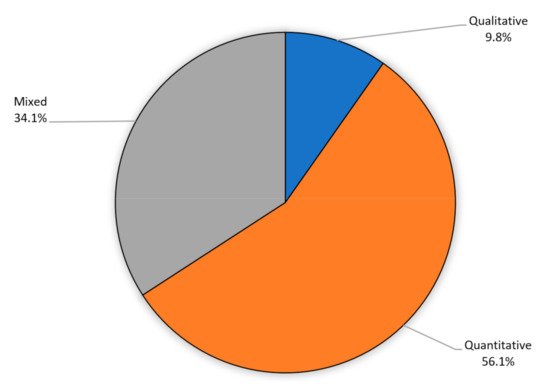This section answers the different research questions and analyses additional aspects of interest.
2.1. Years of Publication of the Evidence Selected
Below are 41 papers from the selected sample (Table 1), in table form and ordered chronologically. The search was made in December 2020 (although some publications from 2021 were already accessible, one of which was included in the end).
Table 1. Identification of studies by year of publication.
As can be observed, the highest number of publications was in 2019 (n = 10), followed by 2018 (n = 9) and 2017 (n = 8). On the other hand, a slight fall in the number of publications was witnessed in 2020 (n = 5).
2.3. Research Methodology
As regards the methodological perspective adopted in the various studies, the quantitative approach is the most prevalent (n = 23). Mixed studies amounted to slightly less than a third (n = 14), and only four were carried out using a qualitative methodological option. Figure 2 shows their distribution in graphic form.
Figure 2. Research methodology.
The vast majority of the studies analysed use the questionnaire as the data collection tool. This tool is used by both quantitative and qualitative studies, in this case, using open-ended questions, where the topics of study may be expressed without restrictions. Specifically, of the 41 papers analysed, a total of 22 used a questionnaire to collect information. We may also observe that quite a few of the studies (n = 10) used the standardised MSLQ questionnaire or a variant to be able to verify the students’ level of self-regulation. As regards qualitative studies, they adopted varied data collection techniques, such as self-reporting, interviews, document analysis or a focus group.
2.5. Self-Regulation Models
The research initiated by Zimmerman
[11] was the forerunner in this field. The concept of self-regulation is understood as a process consisting of self-generated thoughts, emotions and actions planned cyclically to achieve personal goals
[14]. The analysis shows its theoretical influence on the development of the papers, along with other models that have arisen from it (
Figure 4). However, the documents mention more than one conceptualisation to support the development of the research.
Figure 4. Self-regulation models.
Firstly, it is necessary to say that the starting framework, in most papers, is not limited to a single author or conceptualisation. The theoretical perspective most often mentioned in the papers is the cyclical model proposed by Zimmerman
[14] and its later revision
[58] (
n = 25). According to this concept, self-regulation is organised around three phases: anticipation, execution and self-reflection. Below is the model created by Pintrich
[9] (
n = 15) based on four phases aimed at self-regulation of learning: anticipation, monitoring, control and reflection. Both models represent the highest share of the papers analysed. However, there are others, such as Bandura’s social-cognitive model
[59] (
n = 8), the model proposed by Winne and Hadwin
[60] (
n = 7) and Boekaerts’s heuristic model
[6][61] (
n = 5).
Normally, these models offer the basis required by way of theoretical support for the studies considered. Each of them implies a series of inherent presuppositions, though these elements are not always made explicit.
The following table (Table 2) relates, in summary form, the factors that are clearly expressed in the research: technology and SRL level assessment strategies. It should be noted that the table does not seek to establish any kind of relationship but rather simply to illustrate the findings in an orderly manner in the papers analysed in descriptive form.
Table 2. Self-regulation, technology and assessment models.
| Reference Models |
Technological Resources to Promote Self-Regulation |
SRL Assessment Strategies |
| Zimmerman’s cyclical model (2000) |
Infographics
Virtual learning environments (LMS)
MOOC
QR codes
Portfolio |
-Questionnaires
Scales
Interviews with the students
Interview with the teaching staff
Document analysis
-Portfolios |
| Bandura’s social-cognitive model (1986, 1997) |
Virtual learning environments (LMS)
Tutorials
PLE
Virtual reality |
Scales
Questionnaires
Portfolios |
| Boekaerts’s Heuristic Model (1995, 1996) |
Virtual learning environments (LMS) |
Questionnaires |
| Winne and Hadwin (1998) |
Virtual learning environments (LMS)
Intelligent tutoring system |
Questionnaires
Scales |
Pintrich Model
(2000) |
Virtual learning environments (LMS)
MOOC |
Questionnaires
Scales |
The LMSs adopted by the institution are usually the most-studied technological factor aimed at making it easier for students to achieve their aims and to achieve self-regulation. That may be due, firstly, to their extensive presence in universities; also, and as a result thereof, the teaching staff and students’ familiarity with and knowledge of the environments and their tools would be determining factors. At all events, a large share of the studies reviewed, albeit they discuss some technological resources, do not analyse in detail the involvement of these elements in the various aspects of self-regulation nor in how they are used or may affect regulation of learning.




